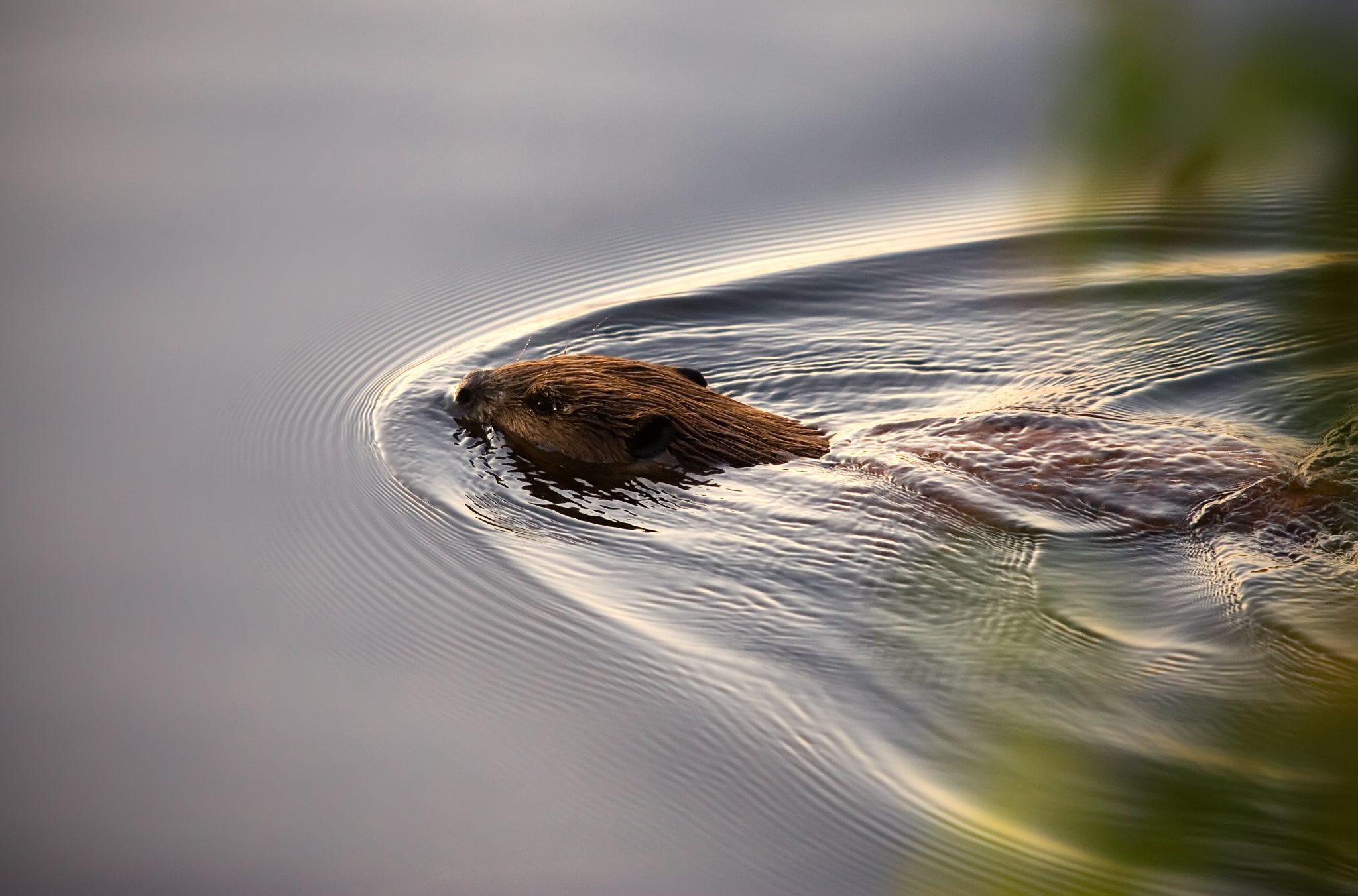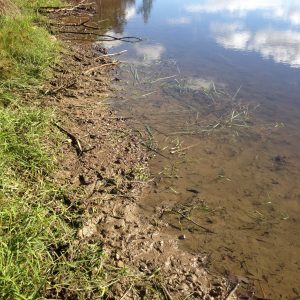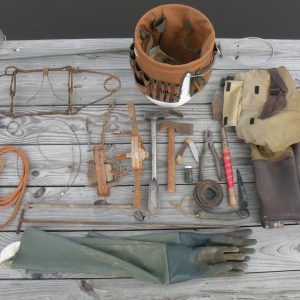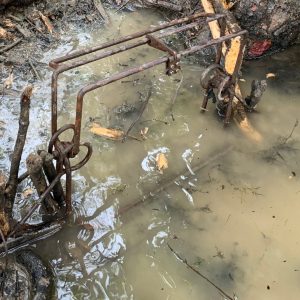Forestry & Wildlife

Beaver play a crucial role in the ecosystems where they live, engineering habitat which generates a tremendous diversity of plants, animals, and aquatic life. However, beaver numbers in Alabama have increased to the point of causing millions of dollars in economic damage annually. The largest losses result from cutting timber and flooding timberlands, agricultural crops, and roadways. If your property has water on or nearby it, chances are you will have a run-in with beaver.
Beavers are territorial. Parents force out juveniles around late winter and early spring to recolonize elsewhere. Most juveniles travel between one and 3.5 miles to find a suitable home site. Once settled, they form colonies averaging four to eight individuals and territories ranging from 20-40 acres. Even though beaver don’t mature until age two or three and have small annual liters of two to three, a breeding pair that is left uncontrolled can have dramatic impacts in a short time.
Beaver Sign and Damage Identification
Telltale signs of beaver presence include: dammed culverts and streams, flooded timber, fields, and roads, girdled or downed timber, cut crops, and stripped limbs. You may also see lodges, bank dens, slides, crossovers, and castor mounds. Muskrat and otter can create sign similar to beaver so it is important to understand the differences so you can correctly identify what species you are confronting. Both muskrat and otter create slides and runs and use bank dens. Muskrat will also create small lodges using cattails and vegetation, unlike beaver that use cut limbs and mud. Since otter are carnivorous, they often leave scat filled with fish scales and bones in areas they frequent. Muskrat will not produce the cut and stripped limbs nor the large, wide basketball-sized runs and entrances to bank dens made by beaver.
Developing a Control Plan
Developing a control plan as soon as possible will help to ensure that the impact of beaver damage is reduced. Because properties and management goals vary, so will control efforts. Prevention, through exclusion or habitat modification, should top any beaver management plan because these techniques are often the most effective and economical means of reducing damage. Where applicable, excluding beaver access to culverts and drains or installing beaver-proof water level control structures is highly recommended. Plans are available through NRCS, but keep in mind that no device is maintenance free. Although generally a temporary solution, destroying dams, dens and lodges (along with the materials used to build them) can sometimes discourage new colonies from taking permanent residence. A small established colony is capable of rebuilding in just a few days. On a small scale, using wire mesh or hardware cloth wrapped around trees/shrubs that you’d like to keep (like those near the pond bank or house) can reduce a site’s attractiveness to beaver and help curb damage before it starts.
Lethal control (shooting and/or trapping) is often a required component of beaver management plans. Before shooting or trapping is conducted, you must check the fur bearer trapping and shooting regulations set by the Alabama Department of Conservation and Natural Resources (ADCNR) as laws can change annually.
Managers must answer several questions when planning to use lethal control methods.
What regulations are behind beaver control? Know that the legal status of beaver, along with seasons, methods-of-take, legal equipment and licenses can vary by state. Additionally, limitations on the destruction of beaver dams varies. Before altering any dam check with ADCNR or your counties Natural Resources Conservation Service (NRCS) office.
Do you have access to the areas where the beaver reside? If not, landowner permission must be sought. Surrounding landowners may be glad to allow access for beaver control as they are likely experiencing damage as well. Consider enlisting as many neighboring property owners as possible in beaver control efforts for more effective and longer lasting control. Sharing the duties of setting and running trap lines can also reduce control costs as the fuel and time saved by cooperating properties sharing duties can be tremendous.
Do you have time to shoot them? Because beaver are primarily active at night, shooting is not as effective or as economical as trapping because you have to be there when the beaver are active. This is particularly difficult when beaver are numerous as it can take many late nights and long hours to achieve control. Night shooting is only allowed under special permission granted by your regions ADCNR biologist/warden. Covering light sources with a red lens or cellophane will not frighten the beaver and provide more time for an effective and ethical shot. A shotgun loaded with BB or larger shot is more effective and preferred over center fire rifles that increase the risk of dangerous ricochets.
Do you have the know how or are you willing to learn to trap beaver? The skill required to be an effective and humane trapper comes with a learning curve. If you can shadow an experienced trapper, do so, ask questions, and observe. If not, there are many resources available to get you up to speed. National and state trapping associations, your state’s Cooperative Extension state fish and game agencies, as well as Internet forums and online videos are available to help you become an effective trapper. For example, the Alabama Cooperative Extension System has an excellent “how to” series of YouTube videos about trapping beaver. A major concern is avoiding non-target catch and human safety. For example, are the neighborhood pets at risk? Do you have otter or muskrats using the property? Is human safety—primarily children—a consideration? As a trapper, you are liable for any damages that occur because of your traps.
- High traffic shoreline, stripped limbs, and beaver tracks.
- Beaver trapping equipment.
- Beaver trapping.
Equipment
The equipment needed for effective beaver trapping is not a short list but chances are that you already have some of the required tools. The must-haves for beaver trapping include:
- variety of traps (330 or larger body gripping, #3-#5 footholds, snares)
- body gripping trap safety catch
- body gripping setting tool or rope
- release stick
- trap tags (again, check state game laws for tagging requirements)
- 9-14 gauge wire
- lineman pliers
- 3/16” quick links
- folding hand saw
- variety of rebar staking (15-36 inches)
- small sledge-type hammer backed with a chisel
- castor gland lures (can be made from the glands and oil sacs of caught beaver)
- bucket or pack basket to carry it all
- gauntlet gloves (waterproof, elbow to shoulder length gloves)
- waders (hips boots are generally too short)
Most equipment can be found at online trapping suppliers and local farm supply stores. Before purchasing your supplies, consider the areas and environment that you will be trapping. Weight is a consideration for long hikes or hard to access beaver haunts so snares may be the trap of choice because they are light and easily packable. Water depth, soil, and plant growth will also dictate length of drown cables and staking.
Traps and Sets
The most commonly used traps for beaver include: 330 body gripping traps, #3 to #5 coil and long spring foot holds, and snares. Target high activity areas including entrances and exits to lodges or bank dens, canals, runs, slides, and crossovers. Water depth and surrounding cover will often dictate the trap and set used.
Body gripping traps, also known as conibears, are a kill on contact trap. Several sizes are available but the 330 or 8 x 10-inch size is most commonly used for beaver. This versatile trap can be set in many different configurations on a variety of travel areas and depths, even under ice. They are especially effective placed at the entrances of dens and lodges and at most crossovers or any other restriction that concentrates beaver travel. This style of trap is one of the more dangerous and difficult to set without proper training and practice and must be set in water in the state of Alabama.
Large, #3 to #5 coil and long spring foot hold traps are almost exclusively used on drowning sets for beaver. They are often placed at areas near the shore where beaver exit the water or on the face of a dam. An effective drowning set requires a taut cable with a drown slide that can access 3 feet of water and is anchored by at least 30 pounds. A foot hold is attached to a one-way drown lock and placed just beneath the surface near the water’s edge for a front or hind foot catch. This set can be effective in trapping beaver that won’t venture through a conibear.
Snares are perhaps the most versatile and economical trap style available. The primary limitation for snaring is difficulty placing them at depths greater than 12 inches. If not on a drown set, they must restrain a live beaver which can cause pelt wear and require more frequent checking. Snares can prove safer for humans to use and some snare sets allow for non-target catches to be released. In Alabama, snares must be set in water.
Safety and Ethics
No matter which trap type is used, it is important to secure them so that the captured animal cannot escape, be injured, or otherwise suffer and so that water current, predators, or domestic dogs don’t drag your catch and trap elsewhere. Proper staking depends on soil composition. Stakes 30 inches or longer are often required for sets in loose, sandy or flooded soils. Shorter, 18 to 24-inch stakes can be sufficient in more compacted soils, such as clay or dry land. Some soils are so rocky that staking is not an option, and traps must be cabled or wired to trees/rocks or placed on a drag. Sufficient swiveling is important so that traps do not bind and cause injuries to the captured animal or give the animal adequate leverage to escape. This is especially true when using foot holds and snares.
Trappers are liable for damages that occur as a result of their sets. It is their responsibility to reduce non-target catches and ensure the safety of humans and domestic animals. Do not trap if human and domestic animal safety is at risk. Make every effort to reduce the likelihood of catching out of season animals (i.e. otter and muskrat when out of season). However, despite a trapper’s best efforts to reduce accidental, non-target catches, they do happen. Release the animal when possible. Otherwise contact your state wildlife agency to report any out-of-season catch as required.
It is not recommended that beaver be live-trapped and relocated. Relocating animals is often illegal, often creates a nuisance for another property, stresses both the current population and the individual that is moved and promotes the spread of disease, all while greatly increasing the likelihood of an animal or human injury.
Summary
Controlling beaver is a process. Implementing prevention techniques, identifying damage, reading sign, and using lethal control methods are all part of a successful management plan. If the prospect of controlling beavers is more than you can handle, there are options for assistance and support. The USDA-APHIS Wildlife Services can provide nuisance trapping. During trapping season, private furbearer trappers can help, while ADCNR maintains a list of licensed Wildlife Control Operators that can be called upon at any time.
Whatever plan you develop and techniques you use, it is important to be patient and persistent. As for trapping, sometimes beaver can be captured in just the first few days of a set and other times it may take a week or longer. There is a great difference between effective trapping and efficient trapping. Efficiency can usually only be improved upon with time and experience in the field. Understand and expect that beaver constantly recolonize suitable sites. If one beaver decided that your property would make a good home, chances are others may return to the same area. Remain vigilant and look for signs that beaver are moving in again.




